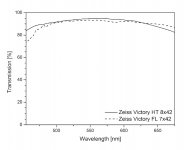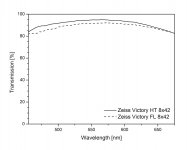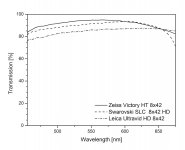Gijs has of course has published a wealth of transmission data, which can be found here:
https://www.houseofoutdoor.com/verrekijkers/verrekijkers-testen-en-vergelijken/
There are lots of interesting comparisons to be made for those wanting to consider their favourite model in relation to other choices (though note the reservation below)
Specifically in relation to the OP, see ‘Testrapport Zeiss Victory HT 8×42’ from April 2013
I’ve attached 2 graphs from it showing from left to right:
- Zeiss Victory HT 8x42 vs FL 7x42, and
- Zeiss Victory HT 8x42 vs FL 8x42
A couple of observations:
- although the FL 7x42 shows generally higher transmission then the FL 8x42, there’s a strange dip at the lowest frequencies (from 450 nm), and
- the maximum difference between the 8x42 HT and FL curves is perhaps 5%, so while there's a measurable difference just how significant is it in practice?
And a more general observation, and one not intended in any way to diminish the usefulness of Gij’s work:
- objective transmission does not necessarily correspond with subjective/ perceived brightness
On one hand, for a given design (where other factors remain constant) increasing transmission will increase visible brightness
e.g. there’s lots of useful information in Gijs data about various models over time, including: Swarovski Habichts, EL SV’s and SLC HD’s and; Leica Ultravid x42’s
However, in considering perceived brightness - when comparing one brand or model to another - one also needs to take into account light/ contrast control factors such as baffling
Tobias Mennle has written extensively on this, and it's considered in most of his reviews. For a starting point see here:
http://www.greatestbinoculars.com/allpages/articles/itsthebaffling.html
It’s clear from Tobias’ work - in conjunction with Gijs’ - that Leica in deciding the optical image their binoculars will have,
chooses to take a significantly different approach to that of Zeiss or especially Swarovski (for an indication, see the 3rd graph from Gijs' article showing the Leica 8x42 UV HD)
And especially when reading comparative reviews of other brands that equate subjective brightness with transmission, one needs to be mindful of the above
- there really is a lot more going on than meets the eye!
John









